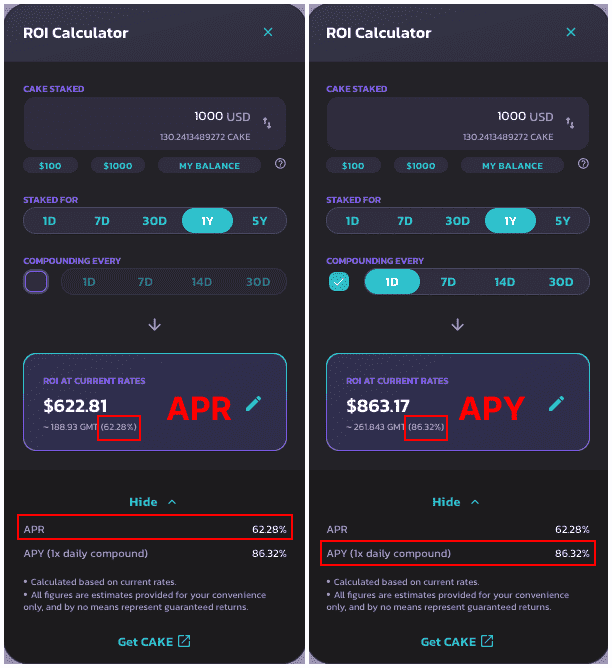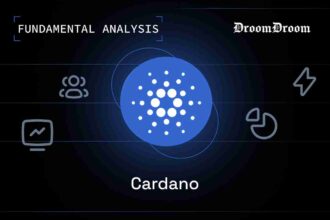Blockchain technology has been revolutionary in several ways; one is the creation of decentralized finance (DeFi), which is worth billions of dollars, according to data from DeFiLlama. DeFi is a sector within the cryptocurrency industry that offers unique financial services, challenging the traditional system. Since it’s a relatively new area, you’ll often encounter specific terminology, such as APR and APY.
- Understanding Annual Percentage Rate And Annual Percentage Yield
- What is Annual Percentage Rate
- What is Annual Percentage Yield
- Differences Between APR and APY
- Factors to Consider When Choosing APR and APY
- Always Consider Compounding
- Compare Like with Like
- Fees and Transaction Cost
- Flexible and Fixed APR and APY
- Volatile Nature of Cryptocurrency
- Platform’s Reputation
- Smart Contract Audit
- Regulatory Compliance
- Conclusion
- Frequently Asked Questions (FAQs)
APR stands for Annual Percentage Rate, which accounts for the interest earned or paid on a principal sum in the context of cryptocurrency. APY, or Annual Percentage Yield, takes into account the interest earned or paid on a principal sum that includes the effects of compounding.
While these terms are frequently used, particularly by those involved in cryptocurrency, they refer to entirely different concepts. They differ in how they’re calculated and the contexts in which each term is more commonly used. In this article, you’ll discover all you need to know about APR and APY in the context of the cryptocurrency industry.
Understanding Annual Percentage Rate And Annual Percentage Yield
The terms Annual Percentage Rate and Annual Percentage Yield are not specific to the cryptocurrency sector; they are common terminologies used in traditional financial sectors such as banking, lending, and credit cards. However, their application within the cryptocurrency world differs, although they take a similar approach. One of the similarities is that in both sectors, APR is typically a more favorable metric for borrowers, while APY is considered a better measure for lenders.
Here’s a complete guide by DroomDroom on all you need to know about decentralized Finance DeFI.
In the cryptocurrency industry, they are used interchangeably across several projects. This includes crypto lending platforms, staking platforms, yield farming, mining, and Constant Function Market Makers (CFMM) platforms. The choice of which term to describe the services accurately depends on the platform and how best it describes the financial service or product offered to users.
What is Annual Percentage Rate
The annual percentage rate (APR) is the total interest earned on a staked investment or the interest paid on a loan over a year. Investment earnings and interest payments are usually made in cryptocurrency.
Unlike the Annual Percentage Yield (APY), APR does not consider the compounding of interest, making it more straightforward to calculate potential returns. Since APR does not reflect the compounding effect, it may not provide an accurate picture of returns over time—for the complete duration of the investment or loan.
To calculate your APR on an investment provided (such as liquidity) or on a loan received, you would multiply the interest rate by the principal amount, which is the initial investment or loan amount.
Here’s a possible scenario:
Suppose you decide to stake 1,000 units of a particular cryptocurrency, say Ether (ETH), in a staking protocol that advertises a 10% APR. Your return will be 1,000 multiplied by 10%, giving you 100 ETH. By the end of the staking period, you would receive 1,100 ETH.
However, there’s a formula you can use to determine the value of your APR:
A = [P × (1 + (R × T))]
Where:
A is the amount you will have after the investment period,
P is the principal amount (initial investment),
R is the rate (the projected APR as a decimal), and
T is the time duration of the investment in years.
Let’s review another example using this formula. In this scenario, imagine you’re a borrower. You borrow 5,000 USD of a stablecoin, such as USDT, on a DeFi lending platform. The platform charges a 7% APR on the borrowed amount.
Here’s how the formula applies:
A = [5000 × (1 + (0.07 × 1))]
A = [5000 × (1 + 0.07)]
A = [5000 × 1.07]
A = 5,350 USDT.
This means, at the end of the year, you would need to pay back the initial 5,000 USDT along with an additional 350 USDT in interest.
What is Annual Percentage Yield
Annual Percentage Yield (APY) represents the total amount earned on a staked investment or the amount paid on a loan over a specific duration, considering the effects of compounding interest. Similar to APR, the APY in the cryptocurrency context is also dealt with in cryptocurrency.
APY is considered a more precise metric because it includes the impact of compounding over the period. Unlike APR, which does not factor in compounding, APY can be more complex to calculate due to the inclusion of compounding interest and its frequency. The compounding frequency is critical; it can be daily, weekly, monthly, quarterly, or yearly—the more frequent the compounding, the greater the APY.
This is why, all other variables being equal (principal, rate, duration), APY will typically be higher than APR because it involves periodic compounding of interest.
To calculate APY, one doesn’t simply multiply variables; instead, a more complex formula is used:
APY = (1 + r/n)^(nt) – 1
Where:
r = annual interest rate (as a decimal),
n = number of times interest is compounded per year,
t = number of years.
Let’s revisit the scenarios mentioned earlier to illustrate this:
Scenario 1: You stake 1,000 units of ETH in a staking protocol that advertises a 10% APR. Now, suppose the protocol compounds interest quarterly.
According to our formula, APY = (1 + 0.10/4)^(4*1) – 1
APY = (1 + 0.025)^4 – 1
APY ≈ 0.1038 or 10.38%
Your returns would be 10.38% of 1,000 ETH, which equals 103.8 ETH.
Scenario 2: You borrow 5,000 USDT on a DeFi lending platform with a 7% APR, with interest compounded monthly. The APY would be calculated as:
APY = (1 + 0.07/12)^(12*1) – 1
APY = (1 + 0.00583)^12 – 1
APY ≈ 0.0723 or 7.23%
The cost of borrowing would be approximately 7.23% of 5,000 USDT, which equals about 361.50 USDT for the year.
In both scenarios, we use the respective metrics to demonstrate the outcomes for APR and APY. As you can observe, APY results in a higher return in both instances. These examples illustrate the perspectives of both lenders and borrowers.
This shows that borrowers may prefer APR because it results in lower payments, while lenders prefer to favor APY because it leads to higher returns over time.
Here is a practical example displayed in the Image below:

This tweet below captures the difference between APR and APY in numbers:
While there isn’t a strict rule for using APY, it is commonly found in liquidity pools and other yield-generating products where the compounding effect can significantly enhance earnings.
Differences Between APR and APY
The distinction between APR and APY is critical in financial contexts. While some differences have been highlighted earlier, a deeper dive into each term can be framed around the compounding effect, the accuracy of returns, and their respective use cases in cryptocurrency. Let’s examine each of these factors:
Compounding Effect
The compounding effect is a key differentiator. APY incorporates the effect of compound interest based on the frequency of compounding, leading to potentially higher returns due to the interest-on-interest effect. APR, on the other hand, is a more straightforward measure that does not account for compounding. With all other variables held constant, APY will generally produce a higher return than APR, particularly with more frequent compounding periods.
Accuracy of Return
There is also a significant difference in how each metric accounts for the overall costs and the actual return over time. APR may not reflect the true cost of borrowing or the precise earnings from an investment since it does not include compounding. Taking these factors into account, APY provides a more accurate measure of the actual investment yield or the effective interest rate on loans.
Use Cases in Crypto
While there is no strict rule governing the application of APR and APY in cryptocurrency, specific patterns are evident. APR is often utilized on lending platforms to denote the interest rate on borrowed funds and by staking or yield farming protocols to represent the annualized returns without compounding. Conversely, APY is favored in DeFi protocols to indicate the compounded returns on liquidity provided to pools and in other yield-enhancing products.
Application
The practical application of APR and APY can also influence which metric benefits a borrower or a lender. APR is a more suitable metric for borrowers because it requires a more straightforward calculation of interest without compounding, usually resulting in lower overall repayments. APY is the more attractive metric for lenders or investors seeking to maximize returns as it captures the compounded interest, leading to potentially higher earnings over time.
Factors to Consider When Choosing APR and APY
There are some guidelines for a lender or borrower navigating the cryptocurrency and DeFi landscape. This helps reduce the risk of losses and extra charges, helps maximize potential returns, and minimizes loan repayment.
Always Consider Compounding
Pay attention to the compounding frequency and understand how it affects the APY. You might fall short if you pay attention to such a detail as overestimating return.
Compare Like with Like
Ensure that you compare APR to APR and APY to APY when evaluating different investment opportunities. This way, you’re ensuring you’re getting the best in your decision.
Fees and Transaction Cost
When deciding to go for an advertised APR or APY, also determine other expenses and cost implications that might arise from using the platform, such as the gas fees associated with the blockchain, the cost of the intimating transaction, the cost of withdrawal, among other possible fees and seeing how this affected the proposed APR or APY.
Flexible and Fixed APR and APY
It isn’t uncommon to find that some platforms offer an adjustable or fixed APR/APY. A flexible APR and APY means that they are subject to change due to factors like market conditions, and fixed, on the other hand, represents the APR and APR aren’t subject to change throughout the duration.
Volatile Nature of Cryptocurrency
You should be careful when selecting the crypto assets you’re investing because, in some instances, the assets advertised might offer incredibly high APR or APY, such as high as 500%, but during the investment, duration might have declined far more than whatever percentage was being offered. There might be several reasons influencing this, such as the volatile nature of the market and unfavorable tokenomics, among several other reasons. Technically, this is referred to as Impermanent loss.
Platform’s Reputation
Whether as a lender or borrower, one of your priorities should be selecting a platform for the advertised APR or APY should be the reputation of the platform reputation. This involved researching what their clients reviewed and the platform’s history. Don’t get swayed by platform offerings with little to no presence offering high APR. The benefit of a platform’s reputation is nonnegligible.
Smart Contract Audit
Before selecting a platform simply because of the advertised APR or APY, you need to ensure the platform has undergone a security audit with renowned blockchain audit firms such as Perkshield and CertiK. Certification from these platforms helps ensure your safety.
Regulatory Compliance
Another factor to consider is the legal compliance of the selected platform within your jurisdiction. Also, be aware of future updates on the legal status of the cryptocurrency within that jurisdiction as time passes. This way, you’re protecting your interest.
Conclusion
While APR and APY are used interchangeably, the difference between both is clear, as well as how they can benefit one type of user. Understanding this terminology and how it works will make a user take full advantage of their crypto and DeFi experience.
Frequently Asked Questions (FAQs)
How Does Staking Affect APR?
Seven rules, such as the network conditions and protocol rules, can impact a user’s potential APR before taking. These factors result in many variations in APR after you have locked up your asset. It’s advised that you go over them briefly before deciding to stake.
Factors to Consider Before Taking a Crypto Loan
Before taking out a cryptocurrency loan, you need to consider some possibilities. Loan duration and interest rate should be two primary considerations since they impact the APR paid most. Under normal circumstances, the shorter the loan duration, the higher the APR, except for flash loans, known for their low APR and short-term duration.
Why Should I Consider Compounding Frequency?
Whether you’re a borrower or lender,r paying attention to compounding frequency is necessary. This is because the higher the compounding frequency, the higher the APY paid out or received since each round includes the interest earned in previous periods, creating a cumulative effect on your returns.
How Do I Protect Myself Against the Risk of APR And APY?
APR and APY can be attractive spots for investment or taking out cryptocurrency loans; it’s helpful to consider the types of interest. Is it fixed or variable? Also, consider the platform’s reputation and confirm notable blockchain security audit firms audit it, understand the cryptocurrency market condition, and conduct research thoroughly. These steps help mitigate the risk.
Where Can APR or APY be Found?
So long you’re in cryptocurrency as either a lender trying to invest or deposit for return or as a borrower taking out a loan. In certain instances, you will find APR and APY in lending platforms, staking protocols, liquidity pools, and other yield-generating products. Also, ensure you do your due diligence regardless of where you’ll get your APR or APY.



















